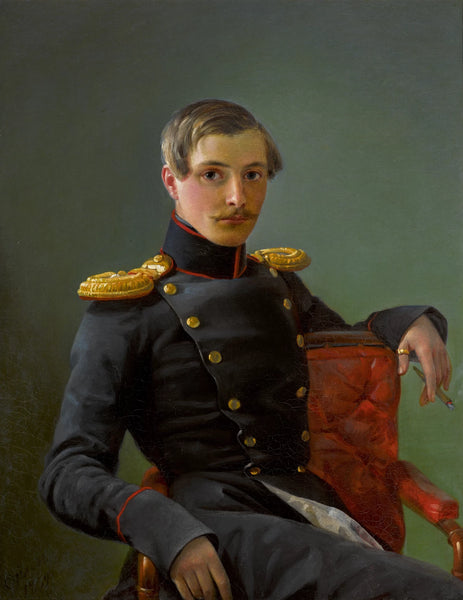When you care about style, a visit to a museum is not only a chance to admire great painters but also an opportunity to admire beautiful renditions of historic garments.
It is always interesting to think about how the clothes of an era symbolises the values of that time and how it has affected the way we dress today.
In the digital age we are all bombarded with lots of photos all the time and it can be nice to take an afternoon at a museum and look at masterpieces that would have taken time and great skill to create. We have chosen to have a closer look at four paintings, to see how they fit within the history of menswear.
Dandyism
Our first work of art is by frenchman James Tissot (1836-1902) and is hung at the Musée d'Orsay in Paris. The painting is called “Le Cercle de la rue Royale” and shows a relaxed afternoon gathering of 12 gentlemen in the heart of Paris in 1868.
Beyond being a beautiful painting of the golden age in Paris, the image is very interesting sartorially. Notice how all men wear traditional tailoring, but how they have been able to differentiate themselves within the strict codes of tailoring. These were aristocratic men with an abundance of time and money who have obviously dressed themselves with care. A houndstooth trouser, a nice pair of gloves, a special shirt collar or a bowtie is enough to stand out while adhering to the rules of elegance.

The role of a gentleman
Art has a great ability to give us insight into the mindset of a specific part of history. This painting by Henri Gervex (1852–1929) can do exactly that.
Through the eyes of the painter, we get to witness “An Evening at Pré Catelan”. The summer evening is drawing to its end and the first people are leaving the beautiful restaurant. The painting is from 1909 and shows the allure of the nightlife of the upper classes in the early twentieth century.
Looking at the clothes, it is easy to notice the colourful and decorated dresses of the ladies in attendance. The all men wear formal white tie and once they are outside, the put on their black coats and top hats before leaving. The balance of the dress codes between genders is what is so interesting. Every man wears an elegant but understated black outfit while the women wear unique and flamboyant dresses.
The dress code of black tie and white tie were put in place to allow all men to look similar, effectively wearing a civilian uniform of black, so that the women were allowed to stand out with their beauty. While this courtesy sounds gallant, it is also quite patronising in that women were mainly admired for their physical beauty, whereas a man had the possibility to be admired for his mind and accomplishments.

Effortless Elegance
Great art is not only beautiful but is also captures a mood. This mood is allows different people to be drawn to different artists, period and styles.
In the famous painting “Wanderer above the Sea of Fog” the German painter Caspar David Friedrich (1774-1840) captures an awesome and melancholic mood.
The painting is from 1818 and the wanderer ha s an air of effortless elegance about him. While on a solitarily walk in the mountains he looks perfectly neat with his dark coat and walking stick while he pauses to thinks about life. What makes this a striking look is that he wears simple and beautiful clothes, all in the same colour, and he is clearly wearing it only for himself. This is what makes him so elegant.

Uniforms
It would be impossible to finish an article about menswear in art without emphasising the beauty and importance of military uniforms.
Throughout history, the military has created practical and decorative garments that have filtered down to our time. Here the Russian painter Pimen Orlov 1812-1863 depicts the young officer Alexander Nikolaevich Karamzin sitting relaxed in his dress uniform smoking. Dress uniforms have often been good at highlighting physical strength, much like ancient armour. Here the golden shoulders and the buttons set in the v-shape of the torso hints towards ideal portions of a military man.
Still today, garments like the bomber jacket, the M65 field jacket, the trench coat, the Parka, chukka boots and even the wrist watch have a clear military heritage.
